Agglomeration Externalities, Network Externalities and Urban High-Quality Development: A Case Study of Urban Agglomeration in the Middle Reaches of the Yangtze River
Abstract
1. Introduction
1.1. Urban High-Quality Development
1.2. Agglomeration Externalities and Network Externalities
2. Theoretical Framework and Research Hypothesis
2.1. Agglomeration Externalities and the Impact of HQD
2.2. Network Externalities and the Impact of HQD
3. Research Area and Methods
3.1. Study Area
3.2. Variable Measures and Descriptions
3.2.1. Explained Variables
3.2.2. Explanatory Variables
3.2.3. Control Variables
3.3. Data Sources
3.4. Research Methods
3.4.1. Social Network Analysis
3.4.2. Entropy Method
3.4.3. Spatial Econometric Model
3.4.4. Spatial Effect Decomposition
4. Results
4.1. Spatial and Temporal Pattern of Urban Network and HQD
4.1.1. Spatial and Temporal Patterns of Urban Network
4.1.2. Spatial and Temporal Pattern of HQD
4.2. Impact of Agglomeration Externalities and Network Externalities on HQD
4.2.1. Baseline Regression Result
4.2.2. Check before Model Estimation
4.2.3. Regression Analysis
4.2.4. Spatial Effect Decomposition
4.2.5. Robustness Test
5. Discussion
5.1. Findings and Contributions
5.2. Optimization Measures
5.3. Limitations
6. Conclusions
Author Contributions
Funding
Data Availability Statement
Conflicts of Interest
References
- Zhu, X.; Qian, T.; Wei, Y. Do high-speed railways accelerate urban land expansion in China? A study based on the multi-stage difference-in-differences model. Socio-Econ. Plan. Sci. 2020, 71, 100846. [Google Scholar] [CrossRef]
- Lu, X.; Chen, D.; Kuang, B.; Zhang, C.; Cheng, C. Is high-tech zone a policy trap or a growth drive? Insights from the perspective of urban land use efficiency. Land Use Policy 2020, 95, 104583. [Google Scholar] [CrossRef]
- Hu, H.; Pan, L.; Jing, X.; Li, G.; Zhuo, Y.; Xu, Z.; Chen, Y.; Wang, X. The Spatiotemporal Non-Stationary Effect of Industrial Agglomeration on Urban Land Use Efficiency: A Case Study of Yangtze River Delta, China. Land 2022, 11, 755. [Google Scholar] [CrossRef]
- Ma, T.; Yin, H.; Hong, T. Urban network externalities, agglomeration economies and urban economic growth. Cities 2020, 107, 102882. [Google Scholar] [CrossRef]
- Long, Y. Measuring the spillover effects: Some Chinese evidence. Pap. Reg. Sci. 2000, 79, 75–89. [Google Scholar] [CrossRef]
- Mccann, P.; Acs, Z.J. Globalization: Countries, Cities and Multinationals. Reg. Stud. 2010, 45, 17–32. [Google Scholar] [CrossRef]
- Lu, J.; Mao, W. The Rise of Urban Network Externalities: A New Mechanism for the High-quality Integrated Development of Regional Economy. Economist 2020, 12, 62–70. (In Chinese) [Google Scholar] [CrossRef]
- Capello, R. The City Network Paradigm: Measuring Urban Network Externalities. Urban Stud. 2000, 37, 1925–1945. [Google Scholar] [CrossRef]
- Van, O.F.; Martijn, B.; Raspe, O. On the Economic Foundation of the Urban Network Paradigm: Spatial Integration, Functional Integration and Economic Complementarities within the Dutch Randstad. ERIM Rep. Ser. Res. Manag. 2009, 47, 725–748. [Google Scholar] [CrossRef]
- Camagni, R.; Capello, R. Caragliu, A, One or infinite optimal city sizes? In search of an equilibrium size for cities. Ann. Reg. Sci. 2013, 51, 309–341. [Google Scholar] [CrossRef]
- Meijers, E.J.; Burger, M.J.; Hoogerbrugge, M.M. Borrowing size in networks of cities: City size, network connectivity and metropolitan functions in Europe. Pap. Reg. Sci. 2016, 95, 181–198. [Google Scholar] [CrossRef]
- Meijers, E.; Burger, M.; Camagni, R.; Capello, R.; Caragliu, A. Static vs. dynamic agglomeration economies. Spatial context and structural evolution behind urban growth. Pap. Reg. Sci. 2016, 95, 133–158. [Google Scholar] [CrossRef]
- Li, Y.; Pan, W.; Wang, J.; Liu, Y. Spatial pattern and influencing factors of high-quality development of China at the prefecture level. Acta Ecol. Sin. 2020, 42, 2306–2320. (In Chinese) [Google Scholar] [CrossRef]
- Li, C.; Wan, J.; Xu, Z.; Liu, T. Impacts of Green Innovation, Institutional Constraints and Their Interactions on High-Quality Economic Development across China. Sustainability 2021, 13, 5277. [Google Scholar] [CrossRef]
- Zhou, T.; Ding, R.; Du, Y.; Zhang, Y.; Cheng, S.; Zhang, T.; Li, M. Study on the Coupling Coordination and Spatial Correlation Effect of Green Finance and High-Quality Economic Development—Evidence from China. Sustainability 2022, 14, 3137. [Google Scholar] [CrossRef]
- Song, R.; Hu, Y.; Li, M. Chinese Pattern of Urban Development Quality Assessment: A Perspective Based on National Territory Spatial Planning Initiatives. Land 2021, 10, 773. [Google Scholar] [CrossRef]
- Cui, D.; Bu, X.; Xu, Z.; Li, G.; Wu, D. Comprehensive evaluation and impact mechanism of high-quality development of China’s resource-based cities. Acta Geogr. Sin. 2021, 76, 2489–2503. (In Chinese) [Google Scholar] [CrossRef]
- Chen, Q.; Bi, Y.; Li, J. Spatial Disparity and Influencing Factors of Coupling Coordination Development of Economy–Environment–Tourism–Traffic: A Case Study in the Middle Reaches of Yangtze River Urban Agglomerations. Int. J. Environ. Res. Public Health 2021, 18, 7947. [Google Scholar] [CrossRef]
- Dong, H.; Han, Y. Spatiotemporal evolution and driving factors of ueban quality development in a complex ecosystem: Taking the seven major urban agglomerations along the Yellow River Basin as examples. Hum. Geogr. 2021, 36, 96–107. (In Chinese) [Google Scholar] [CrossRef]
- Li, P.; Zhang, X. Agglomeration Externalities of City Cluster: Analysis from Labor Wage Premium. Manag. World 2021, 37, 121–136. (In Chinese) [Google Scholar] [CrossRef]
- Yang, W.; Fan, F.; Wang, X.; Yu, H. Knowledge innovation network externalities in the Guangdong-Hong Kong-Macao Greater Bay Area: Borrowing size or agglomeration shadow? Technol. Anal. Strateg. Manag. 2021, 34, 1020–1037. [Google Scholar] [CrossRef]
- Edward, L.; Glaeser, H.D.; Kallal, J.A.; Andrei, S. Growth in Cities. J. Political Econ. 1992, 100, 1126–1152. [Google Scholar] [CrossRef]
- Jofre-Monseny, J.; Marin-Lopez, R.; Viladecans-Marsal, E. The determinants of localization and urbanization economies: Evidence from the location of new firms in Spain. J. Reg. Sci. 2014, 54, 313–337. [Google Scholar] [CrossRef]
- Camagni, R.; Capello, R.; Caragliu, A. The Rise of Second-Rank Cities: What Role for Agglomeration Economies? Eur. Plan. Stud. 2015, 23, 1069–1089. [Google Scholar] [CrossRef]
- Burger, M.J.; Meijers, E.J. Stretching the concept of “borrowed size”. Urban Stud. 2017, 54, 269–291. [Google Scholar] [CrossRef]
- Duranton, G.; Puga, D. Chapter 48 Micro-foundations of urban agglomeration economies. Handb. Reg. Urban Econ. 2004, 4, 2063–2117. [Google Scholar] [CrossRef]
- Glaeser, E.L.; Ponzetto, G.; Zou, Y. Urban Networks: Connecting Markets, People, and Ideas. Pap. Reg. Sci. 2016, 95, 17–59. [Google Scholar] [CrossRef]
- Johansson, B.; Quigley, J.M. Agglomeration and networks in spatial economies. Pap. Reg. Sci. 2004, 83, 165–176. [Google Scholar] [CrossRef]
- Meijers, E. Polycentric Urban Regions and the Quest for Synergy: Is a Network of Cities More than the Sum of the Parts? Urban Stud. 2005, 42, 765–781. [Google Scholar] [CrossRef]
- Burger, M.J.; Meijers, E.J. Agglomerations and the rise of urban network externalities. Pap. Reg. Sci. 2016, 95, 5–16. [Google Scholar] [CrossRef]
- Huggins, R.; Thompson, P. Networks and regional economic growth: A spatial analysis of knowledge ties. Environ. Plan. A 2017, 49, 1247–1265. [Google Scholar] [CrossRef]
- Boix, R. Networks of cities and growth: Theory, network identification and measurement of the network externality. CiteSeerX 2003, 2003, 13–14. [Google Scholar]
- Boix, R.; Trullén, J. Knowledge, networks of cities and growth in regional urban systems. Pap. Reg. Sci. 2007, 86, 551–574. [Google Scholar] [CrossRef]
- Wetwitoo, J.; Kato, H. High-speed rail and regional economic productivity through agglomeration and network externality: A case study of inter-regional transportation in Japan. Case Stud. Transp. Policy 2017, 5, 549–559. [Google Scholar] [CrossRef]
- Tang, C.; Guan, M.; Dou, J. Understanding the impact of High Speed Railway on urban innovation performance from the perspective of agglomeration externalities and network externalities. Technol. Soc. 2021, 67, 101760. [Google Scholar] [CrossRef]
- Yuan, H.; Xin, L.; Yu, C.; Wei, L. Industrial agglomeration externalities, local governments’ competition and environmental pollution: Evidence from Chinese prefecture-level cities. J. Clean. Prod. 2020, 277, 123455. [Google Scholar] [CrossRef]
- Dupont, V. Do geographical agglomeration, growth and equity conflict? Pap. Reg. Sci. 2007, 86, 193–213. [Google Scholar] [CrossRef]
- Williamson, J.G. Regional inequality and the process of national development: A descripition of the patterns. Econ. Dev. Cult. Chang. 1965, 13, 3–45. [Google Scholar] [CrossRef]
- Camagni, R.; Salone, C. Network Urban Structures in Northern Italy: Elements for a Theoretical Framework. Urban Stud. 1993, 30, 1053–1064. [Google Scholar] [CrossRef]
- Volgmann, K.; Rusche, K.; Weesep, J.V. The Geography of Borrowing Size: Exploring Spatial Distributions for German Urban Regions. Tijdschr. Voor Econ. En Soc. Geogr. 2020, 111, 60–79. [Google Scholar] [CrossRef]
- Chen, Y.; Sun, B. Does “agglomeration shadow” exist in Beijing-Tianjin-Hebei region? Large cities’ impact on regional economic growth. Geogr. Res. 2017, 36, 1936–1946. (In Chinese) [Google Scholar] [CrossRef]
- Gao, P.; Ning, Y.; He, D. Evolution of Spatial Correlation Network of City Clusters in Middle Reaches of the Yangtze River Based on Producer Services. Areal Res. Dev. 2021, 40, 61–66. (In Chinese) [Google Scholar] [CrossRef]
- Zheng, W.; Du, N.; Yang, Y.; Wang, X.; Xiong, Z. Multi-fractal characteristics of spatial structure of urban agglomeration in the middle reaches of the Yangtze River. Acta Geogr. Sin. 2022, 77, 947–959. (In Chinese) [Google Scholar] [CrossRef]
- Chen, Y.; Miao, Q.; Zhou, Q. Spatiotemporal Differentiation and Driving Force Analysis of the High-Quality Development of Urban Agglomerations along the Yellow River Basin. Int. J. Environ. Res. Public Health 2022, 19, 2484. [Google Scholar] [CrossRef] [PubMed]
- Liu, J.; Zhang, L.; Zhang, N. Analyzing the South-North Gap in the High-Quality Development of China’s Urbanization. Sustainability 2022, 14, 2178. [Google Scholar] [CrossRef]
- Wang, F.; Wang, R.; He, Z. Exploring the Impact of “Double Cycle” and Industrial Upgrading on Sustainable High-Quality Economic Development: Application of Spatial and Mediation Models. Sustainability 2022, 14, 2432. [Google Scholar] [CrossRef]
- Ma, H.; Xu, X. High-quality development assessment and spatial heterogeneity of urban agglomeration in the Yellow River Basin. Econ. Geogr. 2020, 40, 11–18. (In Chinese) [Google Scholar] [CrossRef]
- Hu, H.; Ma, Y.; Wu, S. Fuzzy comprehensive evaluation on high-quality development of China’s rural economy based on entropy weight. J. Intell. Fuzzy Syst. 2020, 38, 7531–7539. [Google Scholar] [CrossRef]
- Fan, Y.; Fang, C.; Zhang, Q. Coupling coordinated development between social economy and ecological environment in Chinese provincial capital cities-assessment and policy implications. J. Clean. Prod. 2019, 229, 289–298. [Google Scholar] [CrossRef]
- Chen, J.; Zhou, Q. City size and urban labor productivity in China: New evidence from spatial city-level panel data analysis. Econ. Syst. 2017, 41, 165–178. [Google Scholar] [CrossRef]
- He, Y.; Choi, B.R. China’s outward foreign direct investment patterns: Evidence from asian financial markets. J. Asian Financ. Econ. Bus. 2020, 7, 157–168. [Google Scholar] [CrossRef]
- Jiang, J.; Luo, L.; Xu, P.; Wang, P. How does social development influence life expectancy? A geographically weighted regression analysis in China. Public Health 2018, 163, 95–104. [Google Scholar] [CrossRef]
- Li, B.; Qin, H.; Sun, W. Interaction mechanism between industrial transformation and upgrading and green total factor productivity improvement: An empirical study based on 116 China’s prefecture-level resource-based cities. J. Nat. Resour. 2022, 37, 186–199. [Google Scholar] [CrossRef]
- Yao, C.; Song, D. Borrowed scale, network externalities and the economy of urban agglomeration. Ind. Econ. Res. 2019, 2, 76–87. (In Chinese) [Google Scholar] [CrossRef]
- Wei, S.; Pan, J. Resilience of Urban Network Structure in China: The Perspective of Disruption. ISPRS Int. J. Geo-Inf. 2021, 10, 796. [Google Scholar] [CrossRef]
- Liu, L.; Luo, Y.; Peo, J.; Wang, H.; Li, J.; Li, Y. Temporal and Spatial Differentiation in Urban Resilience and Its Influencing Factors in Henan Province. Sustainability 2021, 13, 12460. [Google Scholar] [CrossRef]
- Hi, Y.; Zhu, Q.; Xu, L.; Li, Z.; Wu, Y.; Wang, X.; Fei, Y.; Deng, J. Independent or Influential? Spatial-Temporal Features of Coordination Level between Urbanization Quality and Urbanization Scale in China and Its Driving Mechanism. Int. J. Environ. Res. Public Health 2020, 17, 15872. [Google Scholar] [CrossRef]
- Xu, L.; Wang, D.; Du, J. Spatial-Temporal Evolution and Influencing Factors of Urban Green and Smart Development Level in China: Evidence from 232 Prefecture-Level Cities. Int. J. Environ. Res. Public Health 2022, 19, 3939. [Google Scholar] [CrossRef]
- He, S.; Mei, L.; Wang, L. The Dynamic Influence of High-Speed Rail on the Spatial Structure of Economic Networks and the Underlying Mechanisms in Northeastern China. ISPRS Int. J. Geo-Inf. 2021, 10, 776. [Google Scholar] [CrossRef]
- Li, X.; Liu, H. The Influence of Subjective and Objective Characteristics of Urban Human Settlements on Residents’s Life Satisfaction in China. Land 2021, 10, 1400. [Google Scholar] [CrossRef]
- Chen, K.; Tian, G.; Tian, Z.; Ren, Y.; Liang, W. Evaluation of the Coupled and Coordinated Relationship between Agricultural Modernization and Regional Economic Development under the Rural Revitalization Strategy. Agronomy 2022, 12, 990. [Google Scholar] [CrossRef]
- Shen, W.; Huang, Z.; Yin, S.; Hsu, W. Temporal and Spatial Coupling Characteristics of Tourism and Urbanization with Mechanism of High-Quality Development in the Yangtze River Delta Urban Agglomeration, China. Appl. Sci. 2022, 12, 3403. [Google Scholar] [CrossRef]
- Huang, C.; Liu, F.; Chu, D.; Wang, L.; Liao, J.; Wu, J. Spatiotemporal Evolution and Trend Prediction of Tourism Economic Vulnerability in China’s Major Tourist Cities. ISPRS Int. J. Geo-Inf. 2021, 10, 644. [Google Scholar] [CrossRef]
- Elhorst Paul, J. Matlab Software for Spatial Panels. Int. Reg. Sci. Rev. 2014, 37, 389–405. [Google Scholar] [CrossRef]
- Lesage, J.P.; Pace, R.K. Introduction to Spatial Econometrics; CRC Press: London, UK, 2009; pp. 70–72. [Google Scholar]
- Li, T.; Xue, L.; Li, G. The evolution of spatial pattern of industrial agglomeration and its impact on the high-quality economic development: Empirical analysis based on the data of 278 cities in China. Geogr. Res. 2022, 41, 1092–1106. (In Chinese) [Google Scholar] [CrossRef]
- Guo, J.; Wang, S.; Wang, D.; Liu, T. Spatial Structural Pattern and Vulnerability of China-Japan-Korea Shipping Network. Chin. Geogr. Sci. 2017, 27, 697–708. [Google Scholar] [CrossRef]
- Li, Y.; Ma, S.; Fu, N.; Yi, K.; Peng, F. The Characteristics and Proximity of Cooperative Innovation Network of Marine Industry in China’s Coastal Areas. Econ. Geogr. 2021, 41, 129–138. (In Chinese) [Google Scholar] [CrossRef]
- Liu, L.; Luo, J.; Xiao, X.; Hu, B.; Qi, S.; Lin, H.; Zu, X. Spatio-Temporal Evolution of Urban Innovation Networks: A Case Study of the Urban Agglomeration in the Middle Reaches of the Yangtze River, China. Land 2022, 11, 597. [Google Scholar] [CrossRef]
- Fan, F.; Dai, S.; Zhang, K.; Ke, H. Innovation agglomeration and urban hierarchy: Evidence from Chinese cities. Appl. Econ. 2021, 53, 6300–6318. [Google Scholar] [CrossRef]
- Wang, T.; Liu, C.; Duan, D.; Liu, J.; Zeng, J. The spatial evolution of urban agglomeration competitiveness in the middle reaches of the Yangtze river. World Reg. Stud. 2014, 23, 92–101. (In Chinese) [Google Scholar] [CrossRef]
- Jiang, J.; Xu, Z.; Lu, J.; Sun, D. Does Network Externality of Urban Agglomeration Benefit Urban Economic Growth—A Case Study of the Yangtze River Delta. Land 2022, 11, 586. [Google Scholar] [CrossRef]
- Zhou, H.; Gu, G. The evolution of China’s city network and its environmental effects from the perspective of externalities. Geogr. Res. 2022, 41, 268–285. (In Chinese) [Google Scholar] [CrossRef]
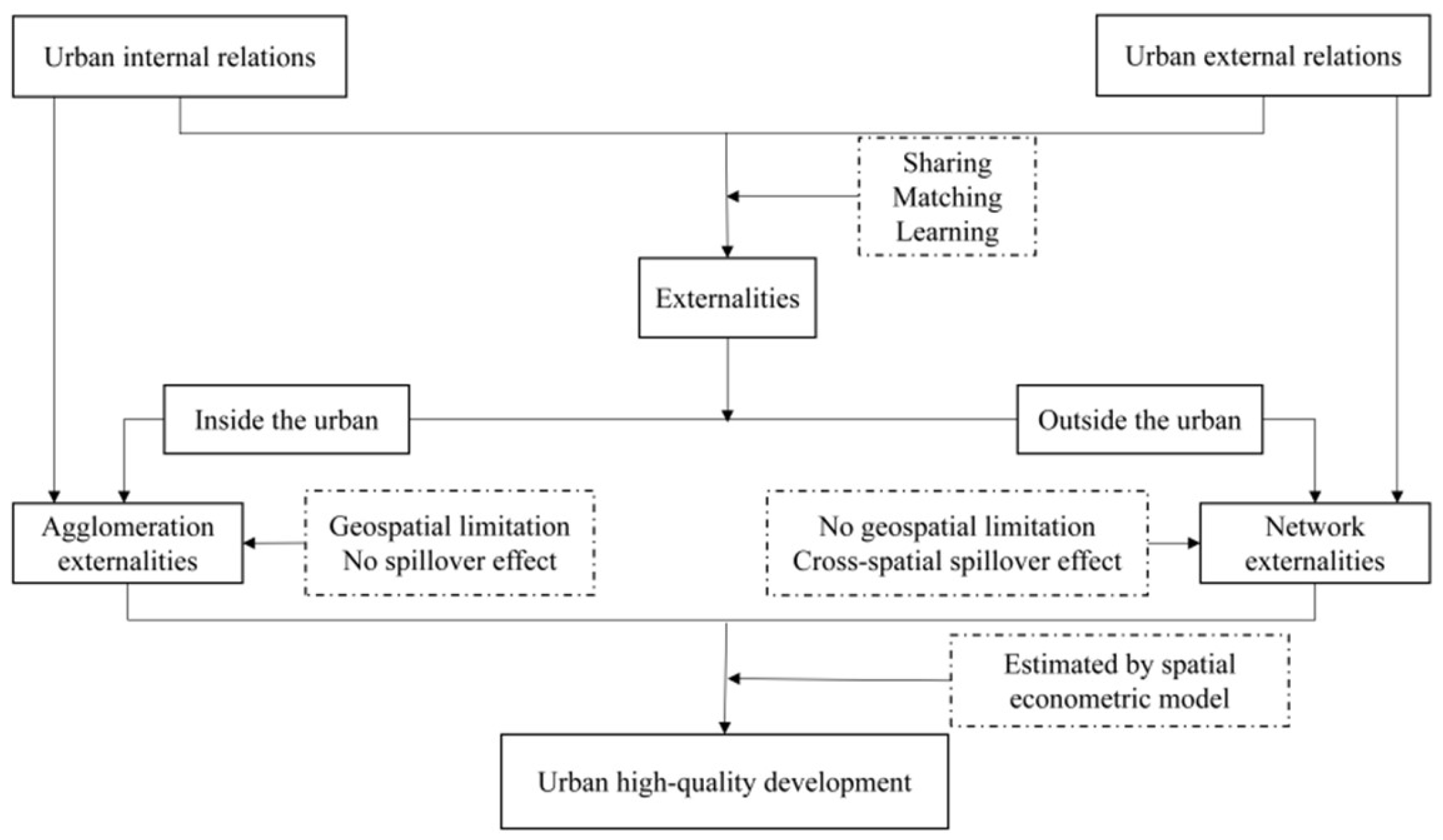
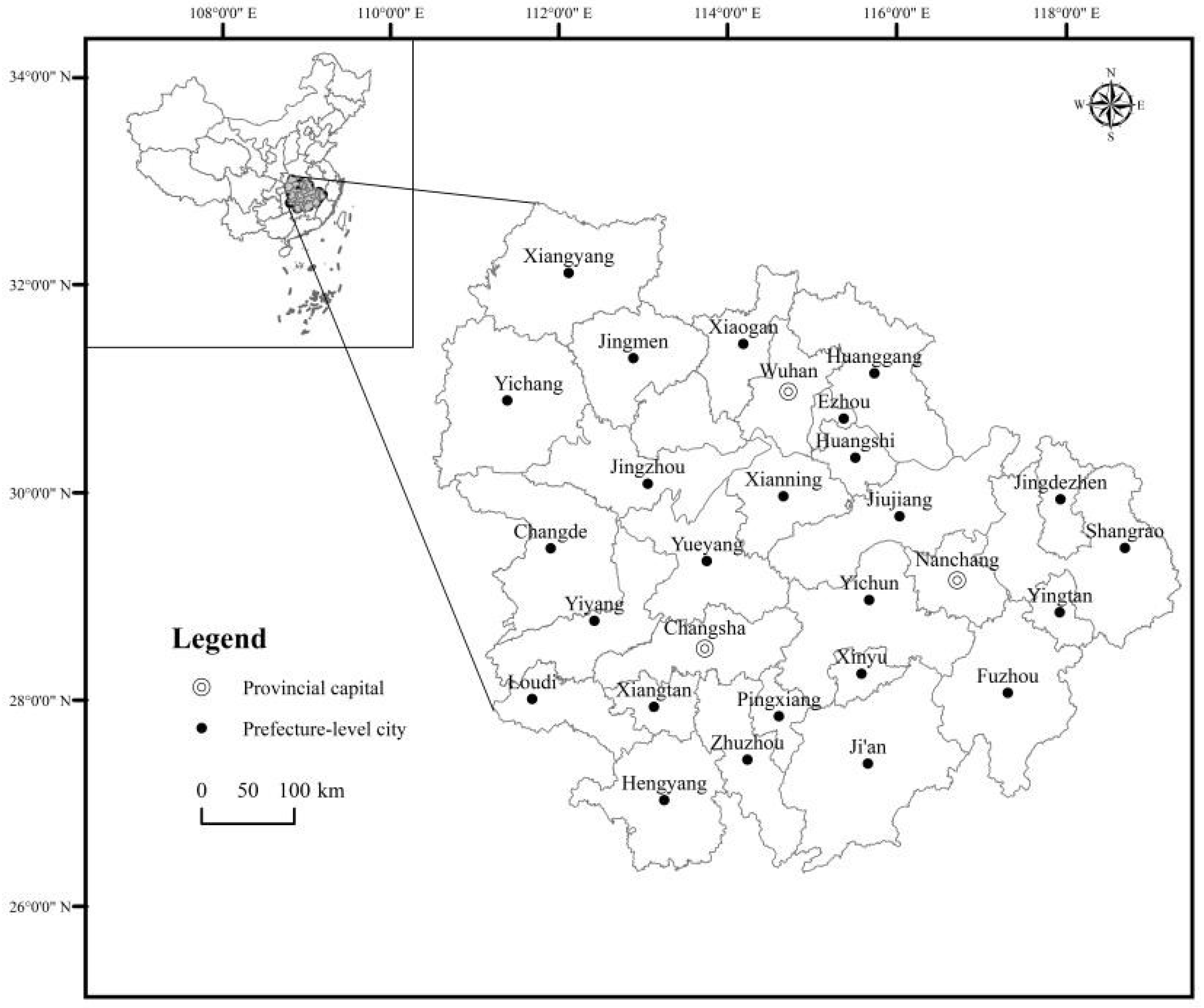
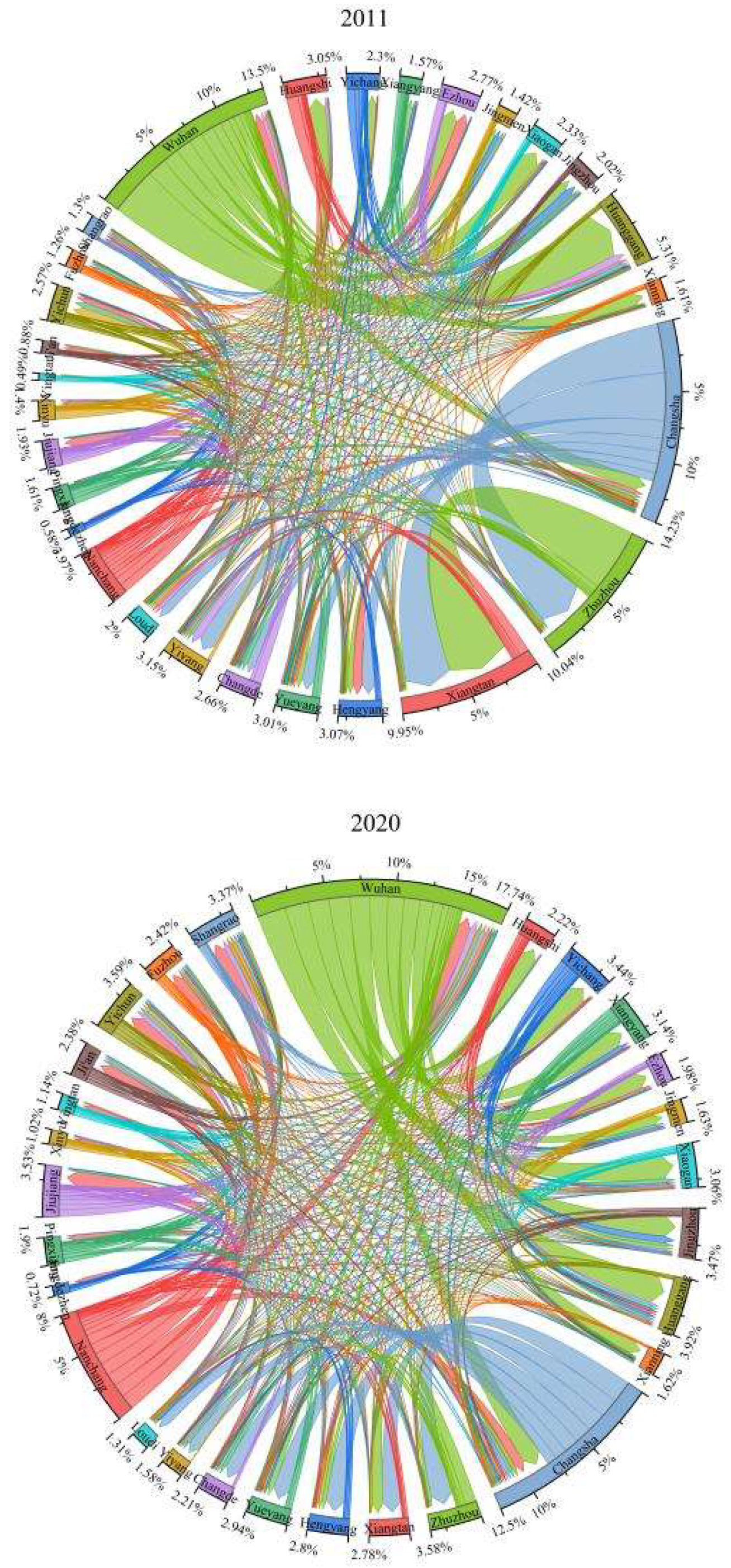
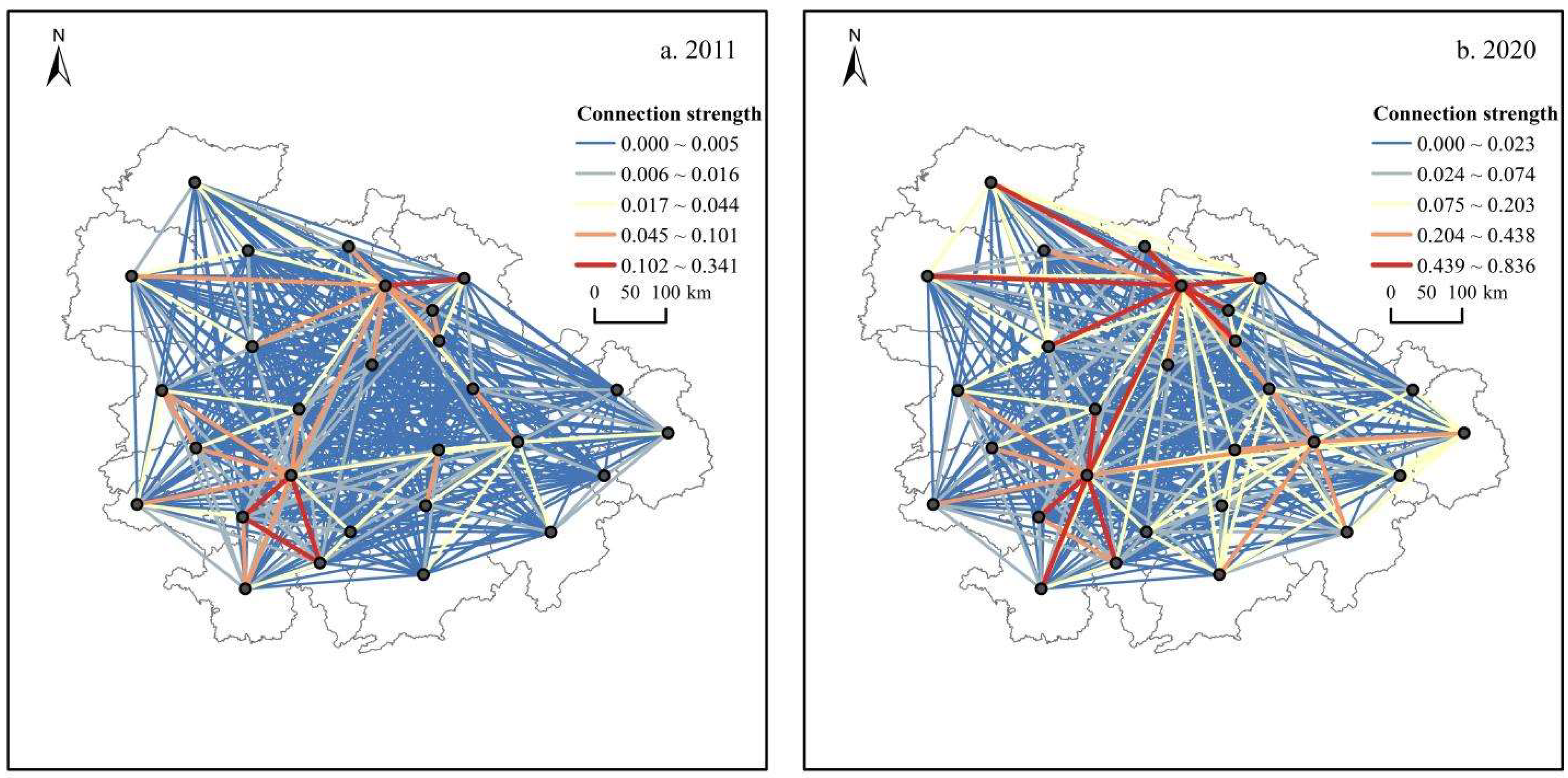
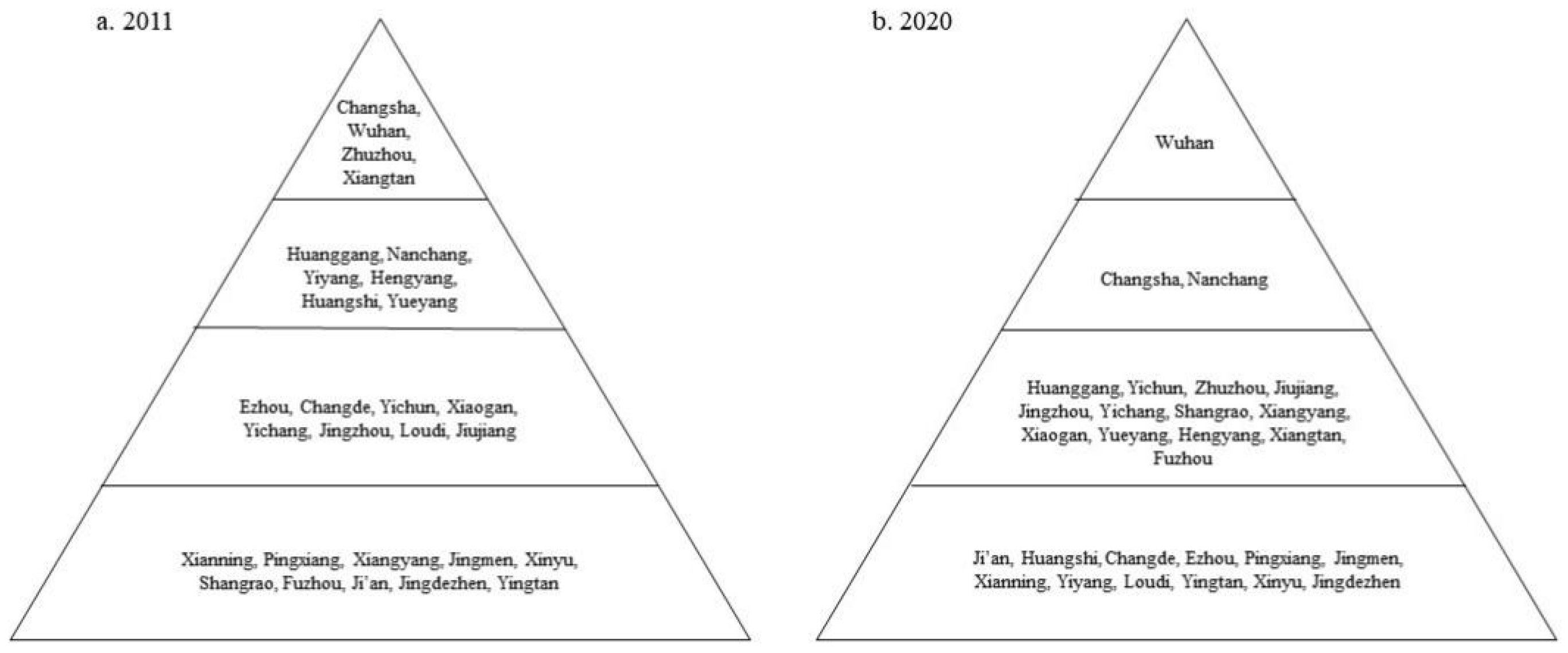
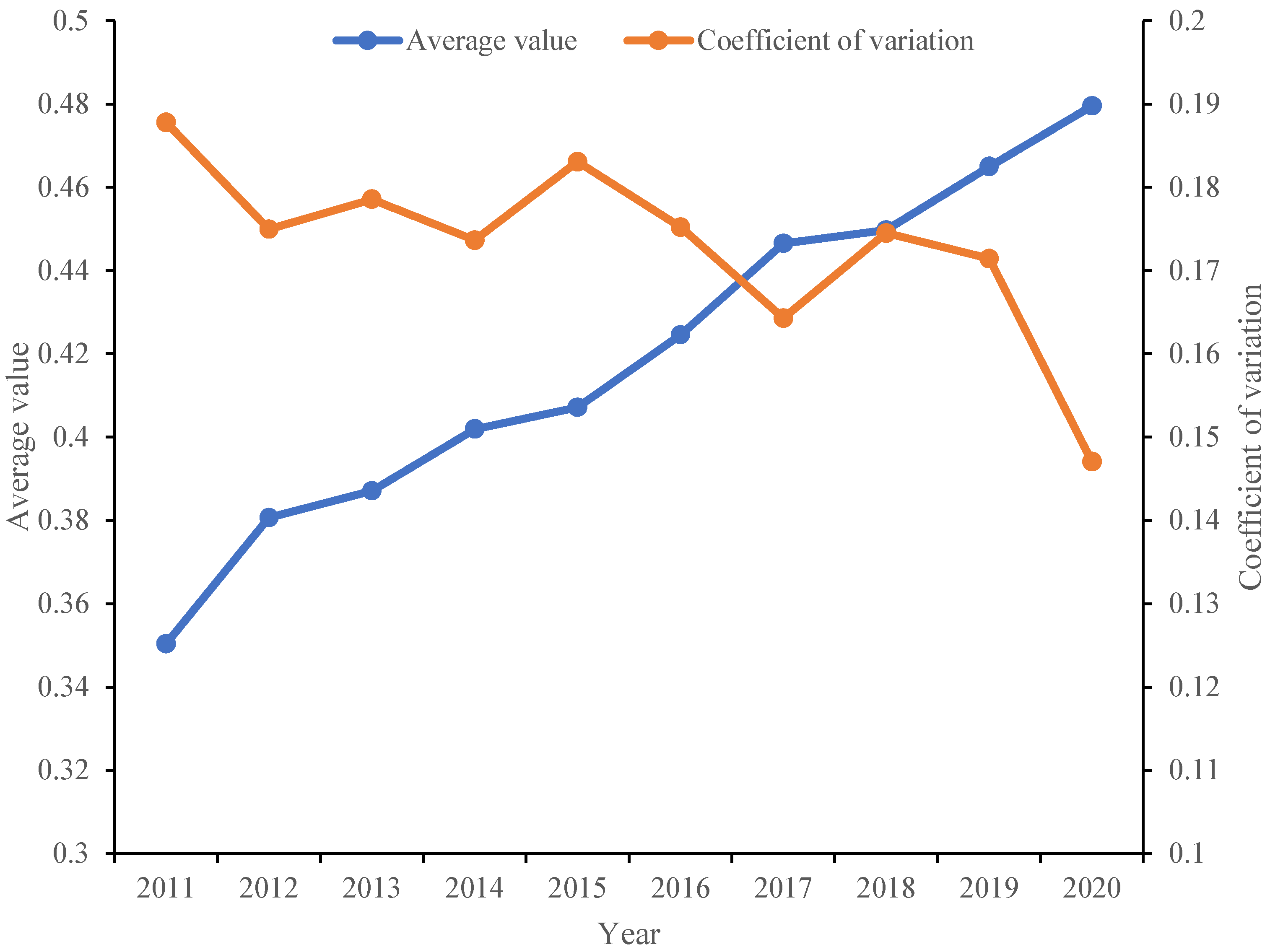
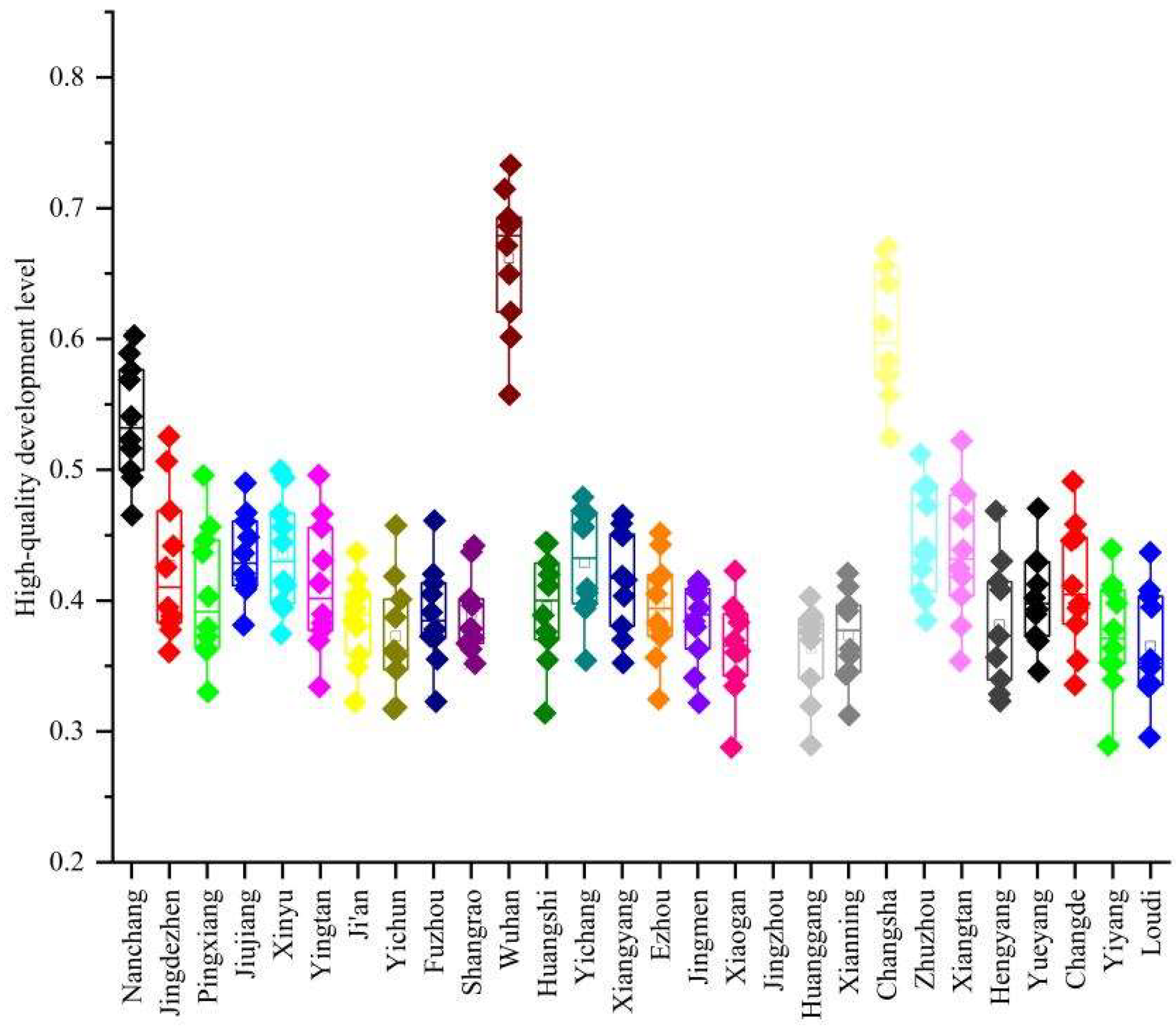
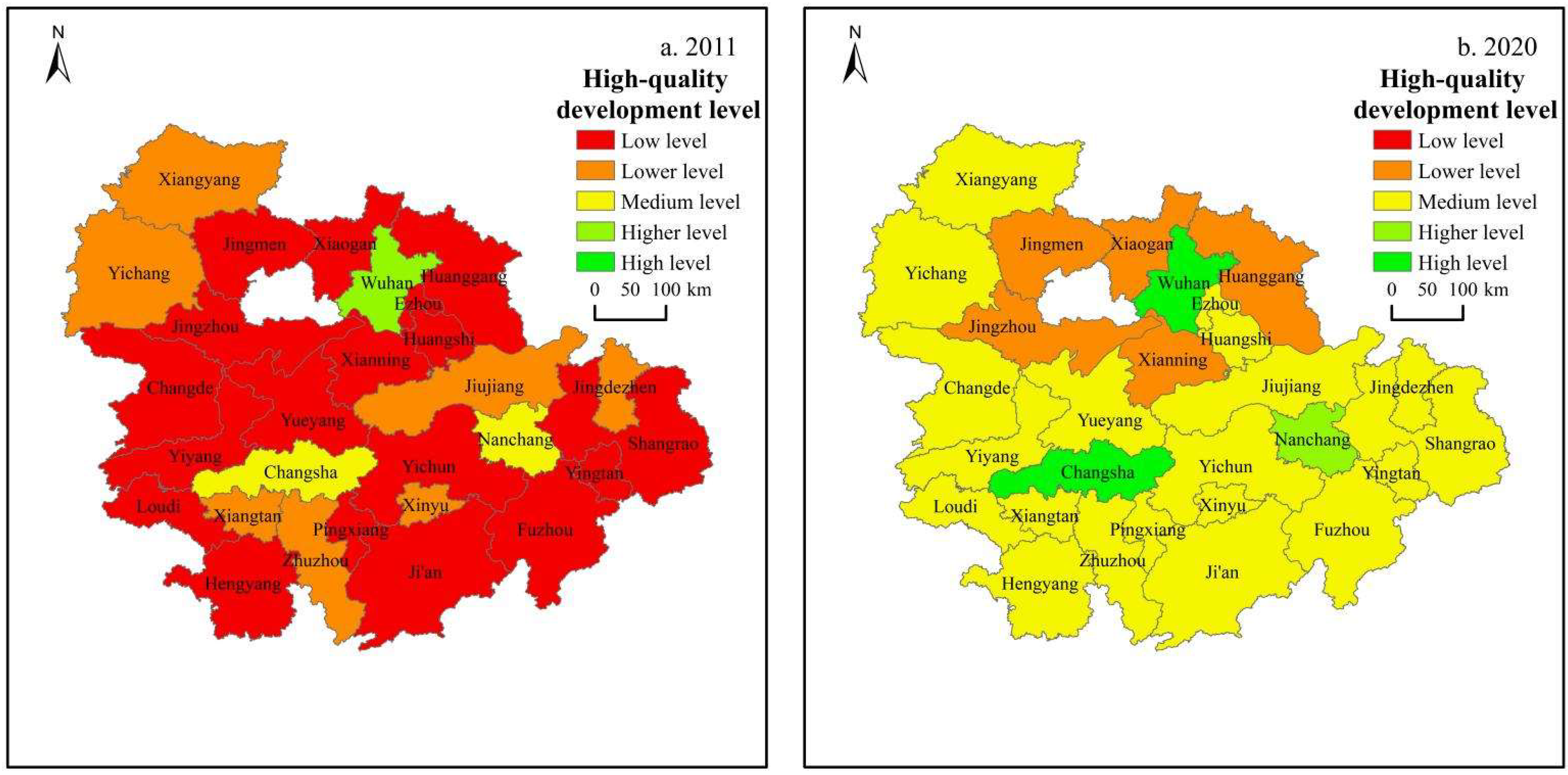
| Target Layer | Criterion Layer | Index Layer |
|---|---|---|
| Innovative development | Innovation environment | Share of expenditure on science and technology; share of expenditure on education; number of colleges per 10,000 people; number of college teachers per 10,000 people |
| Innovation output | Number of patent applications per 10,000 people; number of college students per 10,000 people; percentage of tertiary industry employees; percentage of science and technology employees | |
| Co-ordinated development | Urban–rural co-ordination | Index of disposable income difference between urban and rural residents; the proportion of primary industry in GDP |
| Industrial structure co-ordination | Share of tertiary industry in GDP; index of rationalization of industrial structure; index of advanced industrial structure | |
| Economic stability | Urban registered unemployment rate; economic growth rate; GDP per capita | |
| Inflation level | Consumer price index | |
| Green development | Resource consumption | Electricity consumption per unit of GDP; water consumption per unit of GDP |
| Greening and environmental protection | Green area per capita; green coverage rate of built-up areas; harmless treatment rate of domestic garbage; treatment rate of domestic sewage; comprehensive utilization rate of industrial solid waste; industrial wastewater emissions per 10,000 people; sulfur dioxide emissions per 10,000 people; industrial smoke and dust emissions per 10,000 people | |
| Opening development | Foreign trade | Import and export trade per capita; the number of foreign invested enterprises as a percentage; the actual amount of foreign capital utilized per capita |
| Shipping | Road passenger volume; road cargo volume | |
| Communication situation | Number of cell phone subscribers per 10,000 people; number of postal and telecommunications services per 10,000 people; number of Internet users per 10,000 people | |
| Sharing development | People’s livelihood | Disposable income per capita; average wage of employees on the job; total social consumer goods per capita |
| Cultural benefits | Number of books in libraries per 100 people; number of museums per 10,000 people | |
| Medical benefits | Number of physicians per 100 people; number of medical beds per 100 people | |
| Education benefits | Elementary school teacher–student ratio; secondary school teacher–student ratio | |
| Transportation facilities | Road area per capita; number of public vehicles per 10,000 people | |
| Infrastructure | Gas penetration rate; water penetration rate | |
| Living situation | Living space per capita; real estate development investment per capita; residential development investment per capita |
| Indicators | Calculation Formula | Variable Explanation | Practical Significance |
|---|---|---|---|
| Network density | D is the information network density, N is the number of city nodes in the integrated network, and d(ni, nj) is the number of links between city node i and city node j | The closeness of the city network as a whole and its individual connections | |
| Clustering coefficient | C is the information network clustering coefficient, ei is the number of neighboring edges of city node i, and ki is the number of edges connected to city node i | Clustering of urban nodes in urban networks | |
| Average path length | L is the average path length, and dij is the shortest path between city node i and city node j | Overall transmission performance of urban networks | |
| Weighted degree centrality | WDCi is the weighted degree centrality, Si is the weighted degree, and α is the assignment parameter with a value of 0.5 | Weighting the importance of city nodes in the network |
| Variable Type | Variable | Obs | Mean | Std. Dev. | Min | Max |
|---|---|---|---|---|---|---|
| Explained variables | HQD | 280 | 0.419 | 0.081 | 0.281 | 0.733 |
| Explanatory variables | Density | 280 | 0.336 | 0.177 | 0.005 | 0.882 |
| Density2 | 280 | 0.144 | 0.145 | 0.000 | 0.777 | |
| Degree | 280 | 0.765 | 0.959 | 0.036 | 7.295 | |
| Control variables | ln Gov | 280 | 2.835 | 0.293 | 1.901 | 4.200 |
| ln Innovation | 280 | 3.955 | 0.325 | 1.590 | 4.780 | |
| ln Digital | 280 | 6.670 | 0.908 | 5.325 | 10.085 | |
| ln Opening | 280 | −1.360 | 0.901 | −5.301 | −0.118 |
| 2011 | 2012 | 2013 | 2014 | 2015 | 2016 | 2017 | 2018 | 2019 | 2020 | |
|---|---|---|---|---|---|---|---|---|---|---|
| Nanchang | 0.465 | 0.494 | 0.500 | 0.516 | 0.523 | 0.541 | 0.569 | 0.577 | 0.589 | 0.603 |
| Jingdezhen | 0.361 | 0.378 | 0.383 | 0.388 | 0.395 | 0.426 | 0.442 | 0.469 | 0.506 | 0.526 |
| Pingxiang | 0.330 | 0.362 | 0.364 | 0.373 | 0.380 | 0.403 | 0.437 | 0.446 | 0.456 | 0.496 |
| Jiujiang | 0.381 | 0.409 | 0.411 | 0.416 | 0.421 | 0.436 | 0.461 | 0.449 | 0.467 | 0.490 |
| Xinyu | 0.375 | 0.398 | 0.395 | 0.412 | 0.415 | 0.445 | 0.456 | 0.467 | 0.494 | 0.500 |
| Yingtan | 0.334 | 0.377 | 0.370 | 0.383 | 0.390 | 0.413 | 0.456 | 0.431 | 0.466 | 0.496 |
| Ji’an | 0.323 | 0.349 | 0.358 | 0.380 | 0.385 | 0.394 | 0.406 | 0.403 | 0.416 | 0.437 |
| Yichun | 0.317 | 0.318 | 0.347 | 0.362 | 0.359 | 0.362 | 0.387 | 0.401 | 0.419 | 0.458 |
| Fuzhou | 0.323 | 0.355 | 0.373 | 0.371 | 0.378 | 0.391 | 0.405 | 0.413 | 0.420 | 0.461 |
| Shangrao | 0.352 | 0.363 | 0.367 | 0.379 | 0.372 | 0.379 | 0.401 | 0.396 | 0.437 | 0.442 |
| Wuhan | 0.558 | 0.601 | 0.621 | 0.650 | 0.686 | 0.689 | 0.693 | 0.715 | 0.733 | 0.671 |
| Huangshi | 0.314 | 0.355 | 0.376 | 0.370 | 0.389 | 0.412 | 0.429 | 0.420 | 0.444 | 0.444 |
| Yichang | 0.354 | 0.398 | 0.394 | 0.406 | 0.409 | 0.457 | 0.455 | 0.469 | 0.479 | 0.467 |
| Xiangyang | 0.352 | 0.370 | 0.381 | 0.404 | 0.416 | 0.419 | 0.451 | 0.450 | 0.465 | 0.459 |
| Ezhou | 0.325 | 0.357 | 0.373 | 0.383 | 0.378 | 0.405 | 0.417 | 0.420 | 0.443 | 0.452 |
| Jingmen | 0.322 | 0.341 | 0.363 | 0.380 | 0.384 | 0.394 | 0.413 | 0.406 | 0.409 | 0.415 |
| Xiaogan | 0.288 | 0.360 | 0.335 | 0.343 | 0.361 | 0.370 | 0.390 | 0.383 | 0.395 | 0.423 |
| Jingzhou | 0.281 | 0.309 | 0.298 | 0.329 | 0.342 | 0.370 | 0.385 | 0.386 | 0.399 | 0.394 |
| Huanggang | 0.290 | 0.319 | 0.341 | 0.389 | 0.370 | 0.381 | 0.403 | 0.383 | 0.386 | 0.376 |
| Xianning | 0.313 | 0.346 | 0.344 | 0.363 | 0.358 | 0.392 | 0.392 | 0.397 | 0.421 | 0.411 |
| Changsha | 0.524 | 0.557 | 0.571 | 0.573 | 0.583 | 0.611 | 0.642 | 0.656 | 0.671 | 0.668 |
| Zhuzhou | 0.385 | 0.407 | 0.400 | 0.435 | 0.424 | 0.440 | 0.473 | 0.487 | 0.488 | 0.512 |
| Xiangtan | 0.354 | 0.381 | 0.404 | 0.418 | 0.425 | 0.439 | 0.463 | 0.481 | 0.485 | 0.522 |
| Hengyang | 0.323 | 0.329 | 0.340 | 0.357 | 0.373 | 0.374 | 0.408 | 0.414 | 0.430 | 0.469 |
| Yueyang | 0.346 | 0.369 | 0.373 | 0.390 | 0.393 | 0.402 | 0.430 | 0.413 | 0.429 | 0.471 |
| Changde | 0.336 | 0.354 | 0.382 | 0.398 | 0.394 | 0.412 | 0.448 | 0.446 | 0.458 | 0.491 |
| Yiyang | 0.289 | 0.352 | 0.339 | 0.352 | 0.364 | 0.378 | 0.398 | 0.412 | 0.408 | 0.439 |
| Loudi | 0.296 | 0.349 | 0.336 | 0.338 | 0.335 | 0.355 | 0.395 | 0.408 | 0.403 | 0.437 |
| Year | Moran’s I | Z-Value | p-Value | Year | Moran’s I | Z-Value | p-Value |
|---|---|---|---|---|---|---|---|
| 2011 | −0.196 * | −1.375 | 0.084 | 2016 | −0.215 * | −1.619 | 0.053 |
| 2012 | −0.194 * | −1.394 | 0.082 | 2017 | −0.224 ** | −1.665 | 0.048 |
| 2013 | −0.202 * | −1.473 | 0.070 | 2018 | −0.197 * | −1.421 | 0.078 |
| 2014 | −0.198 * | −1.463 | 0.072 | 2019 | −0.208 * | −1.509 | 0.066 |
| 2015 | −0.209 * | −1.608 | 0.054 | 2020 | −0.143 | −0.886 | 0.188 |
| Variables | Coefficient | Std. Dev. |
|---|---|---|
| Density | −0.206 *** | 0.050 |
| Density2 | 0.306 *** | 0.060 |
| Degree | 0.052 *** | 0.003 |
| ln Gov | −0.014 | 0.009 |
| ln Innovation | −0.006 | 0.007 |
| ln Digital | 0.020 *** | 0.003 |
| ln Opening | 0.019 *** | 0.003 |
| R2 | 0.773 |
| Variables | Multicollinearity Test | Stationarity Test | |||
|---|---|---|---|---|---|
| VIF | 1/VIF | Statistic | Prob | Stationarity | |
| Density | 1.346 | 0.742942 | −3.326 | 0.000 | Stability |
| Density2 | 1.349 | 0.741290 | −3.236 | 0.000 | Stability |
| Degree | 1.196 | 0.836120 | −16.825 | 0.000 | Stability |
| ln Gov | 1.256 | 0.796178 | −2.8588 | 0.002 | Stability |
| ln Innovation | 1.039 | 0.962464 | −7.6985 | 0.000 | Stability |
| ln Digital | 1.326 | 0.754148 | −5.6471 | 0.000 | Stability |
| ln Opening | 1.061 | 0.942507 | −8.5396 | 0.000 | Stability |
| Mean | 1.225 | ||||
| Test Items | Coefficient | p-Value | Test Items | Coefficient | p-Value |
|---|---|---|---|---|---|
| LM_lag | 16.248 | 0.000 | Wald_spatial_lag | 24.000 | 0.001 |
| Robust LM_lag | 19.648 | 0.000 | LR_spatial_Lag | 23.200 | 0.002 |
| LM_error | 1.041 | 0.307 | Wald_spatial_error | 24.940 | <0.001 |
| Robust LM_error | 4.441 | 0.035 | LR_spatial_error | 24.290 | 0.001 |
| Hausman | −7.770 | <0.001 |
| Variables | SLM | SEM | SDM | |||
|---|---|---|---|---|---|---|
| Coefficient | Std. Dev. | Coefficient | Std. Dev. | Coefficient | Std. Dev. | |
| Constant | 0.070 ** | 0.028 | 0.362 *** | 0.036 | 0.129 *** | 0.050 |
| Density | −0.080 *** | 0.028 | −0.060 ** | 0.028 | −0.057 ** | 0.029 |
| Density2 | 0.084 ** | 0.033 | 0.052 | 0.032 | 0.062 * | 0.034 |
| Degree | 0.010 *** | 0.002 | 0.003 | 0.002 | 0.009 *** | 0.002 |
| ln Gov | 0.015 *** | 0.005 | 0.012 ** | 0.005 | 0.010 * | 0.006 |
| ln Innovation | −0.006 * | 0.003 | −0.006 * | 0.003 | −0.005 | 0.003 |
| ln Digital | 0.003 ** | 0.001 | 0.009 ** | 0.004 | 0.005 | 0.004 |
| ln Opening | 0.002 | 0.002 | 0.003 | 0.002 | 0.005 ** | 0.003 |
| W × Density | −0.074 | 0.066 | ||||
| W × Density2 | 0.105 | 0.073 | ||||
| W × Degree | 0.019 *** | 0.004 | ||||
| W × ln Gov | 0.006 | 0.009 | ||||
| W × ln Innovation | 0.000 | 0.006 | ||||
| W × ln Digital | −0.006 | 0.004 | ||||
| W × ln Opening | 0.001 | 0.004 | ||||
| Ρ/λ | 0.762 *** | 0.030 | 0.870 *** | 0.025 | 0.646 *** | 0.045 |
| R2 | 0.747 | 0.493 | 0.817 | |||
| Log likelihood | 679.017 | 669.387 | 692.253 | |||
| Direct Effect | Indirect Effect | Total Effect | ||||
|---|---|---|---|---|---|---|
| Coefficient | Std. Dev. | Coefficient | Std. Dev. | Coefficient | Std. Dev. | |
| Density | −0.085 ** | 0.037 | −0.281 | 0.180 | −0.366 * | 0.207 |
| Density2 | 0.099 ** | 0.043 | 0.371 * | 0.207 | 0.470 ** | 0.239 |
| Degree | 0.015 *** | 0.003 | 0.063 *** | 0.008 | 0.078 *** | 0.010 |
| ln Gov | 0.013 ** | 0.006 | 0.034 | 0.025 | 0.047 * | 0.029 |
| ln Innovation | −0.006 | 0.004 | −0.009 | 0.015 | −0.015 | 0.017 |
| ln Digital | 0.005 | 0.003 | −0.005 | 0.007 | −0.000 | 0.006 |
| ln Opening | 0.006 ** | 0.003 | 0.011 | 0.011 | 0.017 | 0.013 |
| Economic Geographic Matrix | Population Geographic Matrix | |||
|---|---|---|---|---|
| Coefficient | Std. Dev. | Coefficient | Std. Dev. | |
| Constant | 0.285 *** | 0.055 | 0.272 *** | 0.068 |
| Density | −0.046 * | 0.026 | −0.048 * | 0.027 |
| Density2 | 0.055 * | 0.030 | 0.059 * | 0.032 |
| Degree | 0.014 *** | 0.002 | 0.010 *** | 0.002 |
| ln Gov | 0.009 * | 0.005 | 0.008 | 0.005 |
| ln Innovation | −0.005 * | 0.003 | −0.005 * | 0.003 |
| ln Digital | 0.005 * | 0.003 | 0.005 | 0.004 |
| ln Opening | 0.007 *** | 0.002 | 0.007 *** | 0.002 |
| W × Density | −0.121 ** | 0.063 | −0.193 *** | 0.074 |
| W × Density2 | 0.062 | 0.070 | 0.151 * | 0.080 |
| W × Degree | 0.008 ** | 0.004 | 0.011 ** | 0.005 |
| W × ln Gov | −0.031 *** | 0.010 | −0.008 | 0.014 |
| W × ln Innovation | −0.000 | 0.007 | −0.005 | 0.009 |
| W × ln Digital | −0.008 ** | 0.004 | −0.010 ** | 0.004 |
| W × ln Opening | 0.020 *** | 0.006 | 0.022 *** | 0.008 |
| ρ | 0.661 *** | 0.048 | 0.668 *** | 0.053 |
| R2 | 0.860 | 0.846 | ||
| Log likelihood | 725.972 | 710.703 | ||
Publisher’s Note: MDPI stays neutral with regard to jurisdictional claims in published maps and institutional affiliations. |
© 2022 by the authors. Licensee MDPI, Basel, Switzerland. This article is an open access article distributed under the terms and conditions of the Creative Commons Attribution (CC BY) license (https://creativecommons.org/licenses/by/4.0/).
Share and Cite
Liu, H.; Li, X.; Li, S.; Tian, S.; Gong, Y.; Guan, Y.; Sun, H. Agglomeration Externalities, Network Externalities and Urban High-Quality Development: A Case Study of Urban Agglomeration in the Middle Reaches of the Yangtze River. ISPRS Int. J. Geo-Inf. 2022, 11, 555. https://doi.org/10.3390/ijgi11110555
Liu H, Li X, Li S, Tian S, Gong Y, Guan Y, Sun H. Agglomeration Externalities, Network Externalities and Urban High-Quality Development: A Case Study of Urban Agglomeration in the Middle Reaches of the Yangtze River. ISPRS International Journal of Geo-Information. 2022; 11(11):555. https://doi.org/10.3390/ijgi11110555
Chicago/Turabian StyleLiu, He, Xueming Li, Songbo Li, Shenzhen Tian, Yilu Gong, Yingying Guan, and He Sun. 2022. "Agglomeration Externalities, Network Externalities and Urban High-Quality Development: A Case Study of Urban Agglomeration in the Middle Reaches of the Yangtze River" ISPRS International Journal of Geo-Information 11, no. 11: 555. https://doi.org/10.3390/ijgi11110555
APA StyleLiu, H., Li, X., Li, S., Tian, S., Gong, Y., Guan, Y., & Sun, H. (2022). Agglomeration Externalities, Network Externalities and Urban High-Quality Development: A Case Study of Urban Agglomeration in the Middle Reaches of the Yangtze River. ISPRS International Journal of Geo-Information, 11(11), 555. https://doi.org/10.3390/ijgi11110555






